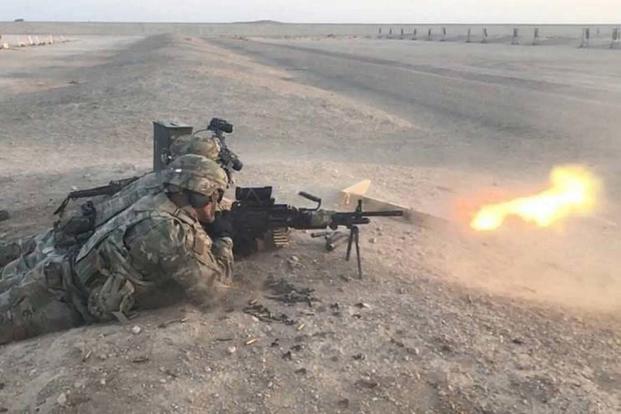The U.S. Army may be close to a breakthrough in lethality with its Next Generation Squad Weapon program, but what will make it truly deadly is the new sighting system that guides the 6.8mm round on target, says the Defense Department official responsible for making Army and Marine infantry squads more lethal.
Since October, the Army has been in discussions with gunmakers about how to develop prototypes of the Next Generation Squad Weapon, or NGSW, using a common, government-designed 6.8mm round. The NGSW will replace the M249 squad automatic weapon and M4 and M4A1 carbines.
To Joe L'Etoile, a veteran Marine officer who leads the Close Combat Lethality Task Force (CCLTF), the most exciting feature of the NGSW is the digital fire control system, which could be revolutionary to infantry squad tactics.
"Three years from now, I would not want to come up against a United States squad when the Next Generation Squad Weapon is fielded with modern fire control system," he said.
Related: Mattis May Be Gone, But His Effort to Revolutionize the Infantry Continues
Today, soldiers and Marines depend on optics that still rely on traditional zeros and marksmanship techniques to put a bullet on target.
"I am doing manual range estimation, so I am going, 'That looks like four football fields away versus three.' Then I've got my striations in my scope, and I do a little hold-over, you know, Kentucky windage-type deal, to hit the target," L'Etoile said. "So, whatever the wind is, whatever the atmospheric conditions are, how hot my barrel is -- none of that is being integrated into the firing solution. The modern fire control system will calculate all of the environmental [conditions] automatically. That technology exists today."
Launched in early 2018, the CCLTF was a top priority of former Defense Secretary Jim Mattis, a retired Marine Corps infantry officer himself.
Today, the task force is overseeing "$3.6 billion [in] reprogramming efforts and additional funding" in the Future Years Defense Program, or FYDP, L'Etoile said, adding that the early stages of the CCLTF gave the Army "some money upfront to accelerate" research and development of the Next Generation Squad Weapon.
Army officials have been tight-lipped about the program ever since the NGSW became a key goal of squad lethality, one of the half dozen modernization priorities under the new Army Futures Command.
In addition to an increased hit probability, the new fire control system will be a key factor in keeping the NGSW's weight down, L'Etoile said.
"Take the modern M4, OK. When I put on that thing all of the accoutrements, it's not a seven-pound weapon ... so when I put a thermal [sight], when I put a laser ... when I put an optic on it and I put a bipod on it, and let's say I put a suppressor on it, right? I've got a 20-pound, .22 caliber rifle," he said. "One of the things you do when you build the Next Generation Squad Weapon, which the Army is very intelligently doing, is they are integrating all of those capabilities into one system ... to include night vision."
The NGSW's fire control will be designed to work with the Integrated Visual Augmentation System, or IVAS, a program Microsoft is developing for the Army under a $480 million contract the service awarded in late November.
IVAS replaces the service's Heads-Up Display 3.0 effort to develop a high-tech digital system allowing soldiers to view their weapon sight reticle and other key tactical information through an advanced goggle or eyepiece.
"So, when I integrate the Next Generation Squad weapon into the IVAS ... I've got my night-vision capability, I've got my operational graphics, I've got the reticle from my weapon in my goggle so I can shoot around corners, I can shoot from defilade -- that is fundamental," L'Etoile said.
This is where L'Etoile sees the technology changing the way squads operate.
As an example, he said there is documentary video of "I believe it's 1st Battalion, 3rd Marines, during the fight of Fallujah."
"But you watch this squad go through the city day after day after day. The tactics that were employed and the capabilities that were employed I would argue go all the way back to 1917," L'Etoile said. "You have people stacked up outside the door, who have no idea what's on the other side of the door ... and at the moment that they make that entry, they have zero advantages against who is opposing them."
Once the first floor is cleared, "the scariest thing you will ever do is to go up a stairwell in an urban area in a kinetic fight," he said, adding that being able to shoot accurately "around a corner without exposing yourself" may well change tactics in the future.
"So, if I can do these things, then what does the stack look like?" L'Etoile asked. "What are the tactics for attacking in an urban area?"
Under the current plan, the Army hopes "to shoot a weapon 27 months from now ... and the IVAS system will leave rapid prototyping by August of 2020 and be ready for production, assuming that we meet all the technical milestones required," he said. "So these aren't some 10- and 15-year visionary-type aspirational programs; these are programs that have relatively short time horizons to realize the capability. ... The science exists, the science is there ... this is not a pipedream."
-- Matthew Cox can be reached at matthew.cox@military.com.










